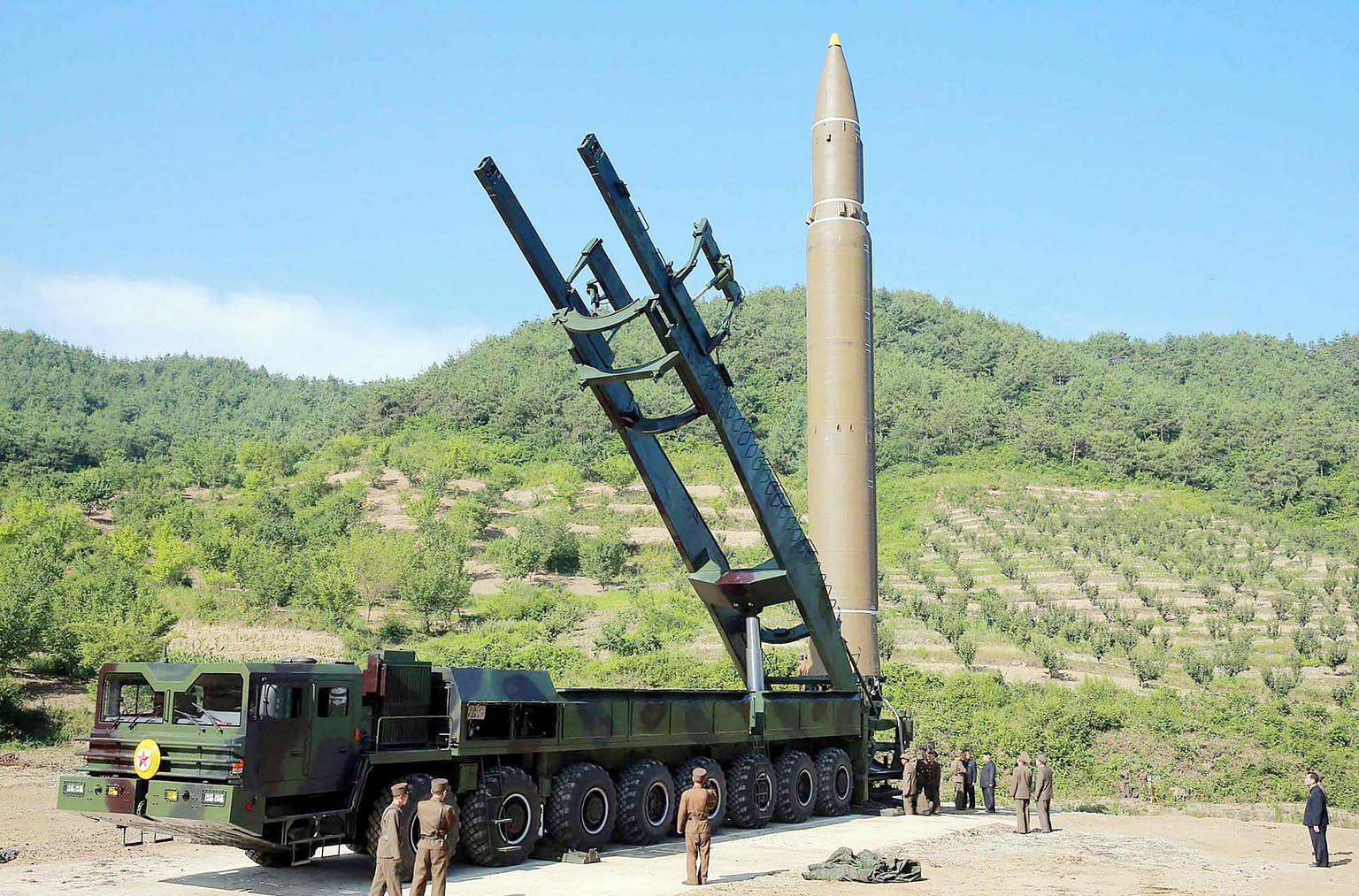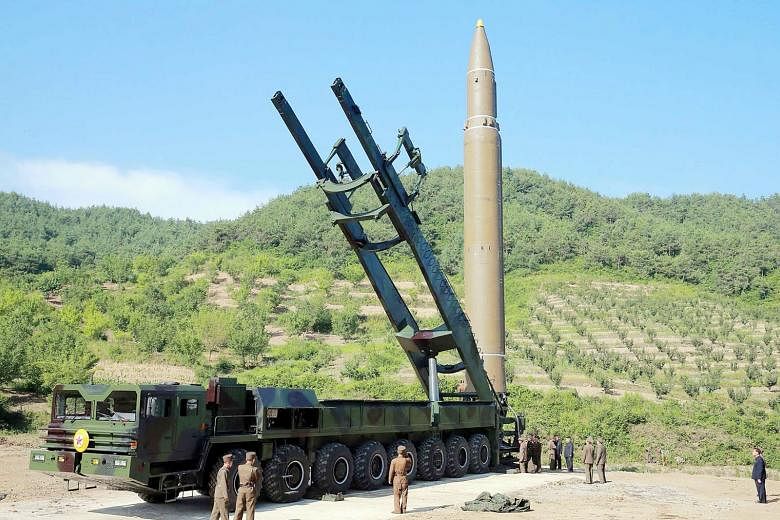North Korea fired its first ICBM, or intercontinental ballistic missile, named Hwasong (Mars)-14 on US Independence Day earlier this week.
Launched in the lofted trajectory, the missile reached the apogee of 2,800km , flew 930km and dived into the Sea of Japan after flying for 37 minutes. If launched in a range-maximising trajectory, the missile would have flown some 6,700km, according to Dr David Wright of the Union of Concerned Scientists.
What does this mean? Can North Korea attack the United States now? In fact, the characterisation of this missile as an ICBM is somewhat misleading. In the US-Soviet arms control talks during the Cold War, the ICBM was defined as "a land-based ballistic missile with a range in excess of 5,500km", based on the distance between the US and the Soviet Union.
However, since North Korea is farther away from the US than Russia, North Korea's "ICBM" might not be so intercontinental. Actually, North Korea needs a missile with a range of 8,000km to 12,000km to hit the lower 48 states in the continental US. Washington DC and New York are about 10,000km away from Pyongyang.
With the estimated 6,700km range, North Korea cannot even hit targets in Hawaii, which is 7,500km away. The best it can do is to hit targets in Guam or Alaska.
Quite ironically, both North Korea and the US have reasons to call this missile an ICBM. North Korea certainly likes to brag about its rapidly improving missile capability. Currently, only the US, Russia and China possess ICBMs. North Korea now stands with these great powers.
The US is happy to characterise this as an ICBM in order to highlight the danger that North Korea is posing to international security. To Washington, North Korea's ICBM is another reason why Beijing has to do a much better job of pressuring Pyongyang. US President Donald Trump might tell Chinese President Xi Jinping to pressure North Korean leader Kim Jong Un or face US "secondary sanctions" on Chinese entities suspected to have illicit deals with North Korea.
WHY NORTH KOREA IS KEEN TO DEVELOP AN ICBM
Some context is needed to understand why North Korea is so keen to develop an ICBM. The state's missile-development programme is essentially geared towards four objectives: To serve as a deterrent in both peacetime and wartime, to allow for limited use of force against South Korea, and to enable brinkmanship diplomacy.

First, North Korea needs to have a peacetime deterrent, to avoid the US launching a preventive strike. By stating that "all options are on the table", the US has hinted at its willingness to use military force against North Korea. In fact, the US seriously considered military action against North Korea in 1994.
I was in Washington that year, conducting some research for the Japan Defence Agency. A US government official approached me and asked whether the Japanese government would support a US decision to go to war with North Korea if it was going to be a short and decisive war. They were serious.
The US abandoned its plans for military action in the end, due to projections in the event of going to war with North Korea. It was estimated that US military casualties would run to 30,000, with a further 80,000 to 100,000 American civilian casualties. If North Korea were able to launch a strike on the US mainland, the death toll would become much higher than this.
Second, in the event of a full-scale war on the Korean Peninsula, North Korea would need to prevent the US from assisting South Korea.
North Korea would try to intimidate the US, saying: "If you help South Korea, we will attack the US with nuclear weapons", or asking: "Would you be willing to sacrifice Washington or New York for Seoul?"
To make such threats more credible, North Korea might even detonate a nuclear bomb off the coast of South Korea as a warning. As North Korea's ICBM technology matures, America's ability to go to South Korea's help wanes.
Third, developing missiles gives North Korea scope to launch limited military strikes against South Korea. Security experts believe that the "stability-instability paradox" is emerging on the Korean Peninsula.
If North Korea has the capacity to attack the US mainland, that will create a situation of mutual deterrence and increase stability at a strategic level. This is good news because there will be a much lower likelihood of full-scale war.
A situation like that, however, makes it easier for North Korea to engage in limited military action, on the expectation that there is no chance of it escalating into a major war. Essentially, stability on a strategic level leads to instability on a tactical level.
If, for example, North Korea fires 10 long-range artillery shells into the vicinity of Seoul, the South Korean military would retaliate by firing 30 shells back into North Korea.
However, with the threat of a nuclear attack hanging in the air, the US would ask South Korea not to further escalate the situation, resulting in a ceasefire. Tightly integrated in the global market, South Korea's country risk premium would shoot up as a result, causing a major capital flight. As an isolated state on the other hand, North Korea would be largely unaffected. This would put South Korea in a very difficult position.
Finally, there is the potential for brinkmanship diplomacy. After launching its ICBM, North Korea once again called on the US to abandon its "hostile policy" towards the country.
This might mean that North Korea is trying to improve relations with the US through coercive actions.
North Korea halted the operation of nuclear facilities for eight years as part of an agreement with the US in 1994, and for a further seven years following an agreement in 2007. In return, the countries party to these agreements provided North Korea with assistance costing US$2.5 billion (S$3.45 billion) and $430 million respectively. In fact, the cost of the second agreement was significantly lower than the first one. A North Korea with ICBM capabilities, however, is sure to demand a far higher price for the next deal.
We have to wait and see what North Korea will try to do with its ICBM.
In any case, there is no good scenario out there, unfortunately. The best we can hope for is the least bad scenario to come into reality.
- The writer is professor and director of the Security and International Studies Programme at the National Graduate Institute for Policy Studies in Tokyo. He is the author of North Korea's Military-Diplomatic Campaigns, 1966-2008.

